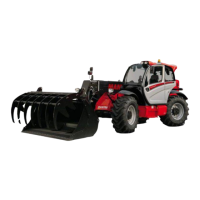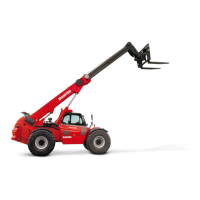1 - 18
F - TAKING UP AND SETTING DOWN A HIGH LOAD ON TYRES
t
IMPORTANT
t
You must not raise the jib if you have not checked the transverse attitude of the telehadler (e INSTRUCTIONS FOR
HANDLING A LOAD: D - TRANSVERSE ATTITUDE OF THE TELEHANDLER).
REMINDER: Make sure that the following operations can be performed with good
visibility (e OPERATION INSTRUCTIONS UNLADEN AND LADEN: D
- VISIBILITY)�
TAKING UP A HIGH LOAD ON TYRES
- Ensure that the forks will easily pass under the load�
- Lift and extend the jib (1) (2) until the forks are level with the load, moving the
telehadler (3) forward if necessary (fig� F1), moving very slowly and carefully�
- Always remember to keep the distance necessary for inserting the forks under the
load, between the stack and the telehadler (fig� F1) and use the shortest possible
length of jib�
- Insert the forks under the load as far as they will go by alternately extending and
lowering the jib (1) or, if necessary, moving the telehadler forward (2) (fig� F2)� Apply
the handbrake and place the forward/reverse selector in neutral�
- Slightly raise the load (1) and tilt the carriage (2) backwards to stabilize the load
(fig� F3)�
- Tilt the load sufficiently backwards to ensure its stability�
- Monitor the longitudinal stability limiter and warning device (
e INSTRUCTIONS FOR
HANDLING A LOAD: C - LONGITUDINAL STABILITY LIMITER AND WARNING DEVICE)�
If it is overloaded, set the load back down in the place from which it was taken�
- If possible lower the load without shifting the telehadler� Lift the jib (1) to release
the load, retract (2) and lower the jib (3) to bring the load into the transport position
(fig� F4)�
- If this is not possible, back up the telehadler (1), manoeuvring very gently and
carefully to release the load� Retract (2) and lower the jib (3) to bring the load into
the transport position (fig� F5)�
1
2
3
F1
1
2
F2
1
2
F3
1
3
2
F4
1
2
3
F5
649100 EN-US-AU (20/05/2019)
MLT 961-145 V PLUS L JD ST4 S1

